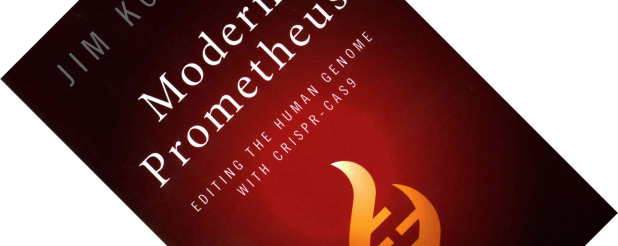After recently reading Doudna & Sternberg’s book A Crack in Creation, this book was the next one I wanted to read to learn more about CRISPR-Cas9, the new technique to edit genetic material that has been taking the world by storm. As it turns out, it was the right order to read the books in. If you have not heard of CRISPR before, I recommend you have a look at my review of Doudna’s book first.

“Modern Prometheus: Editing the Human Genome with CRISPR-Cas9”, written by James Kozubek, published by Cambridge University Press in hardback December 2016 and paperback in June 2018 (440 pages)
Kozubek’s book is a far more technical and in-depth look at CRISPR and the history of genetic modification. It is also a harder read, better suited to an academic, rather than a general audience. The first chapter introduces the discovery and workings of CRISPR, but goes into much more technical detail than A Crack in Creation did.
After this, the book gives an in-depth academic history of the discovery of DNA and how – through RNA – it gets turned into proteins, the discovery of plasmids and restriction enzymes to produce recombinant DNA, the consternation this caused which led to the 1975 Asilomar Conference on Recombinant DNA, horizontal gene transfer, retroviruses, the first gene therapy trials and their failures, and more recent genome editing tools that just preceded CRISPR, namely zinc finger nucleases (ZFN) and TALENs. Is your head spinning already with terminology? Kozubek goes into all the nitty-gritty historical and technical details (and so many gene names). He clearly has done an enormous amount of research, going back to original literature and transcripts from the early conferences, but at times I felt a bit lost in the level of detail – both the people introduced, and the details of their research. Some of this is really interesting; for example, where Doudna only vaguely mentioned the patent spat she had with Feng Zhang, Kozubek spends a chapter on all the ins and outs of how Doudna’s and Zhang’s camps ended up pitted against each other in a legal battle over patent rights to CRISPR.
“The limitations of CRISPR are made very clear […] many of the fantastical scenarios that are being speculated about of genetically enhancing human beings will most likely still not be feasible.”
Through all the people Kozubek interviews, the limitations of CRISPR are made very clear. And with it, some fears seem unfounded. Genes often interact in complex ways, with many having several functions. So knocking out a single gene can have many unforeseen effects. Such is the messy outcome of evolution where genes have been repurposed throughout evolutionary time to function in new ways for which they did not originally evolve (i.e. the biological process known as exaptation). The field of biology has also moved past the simplistic notion of “A gene for trait X”. Complex traits such as human intelligence come about through the interacting effects of thousands of genes, each contributing a little bit, on top of which there is a big influence of the environment on such traits. Keep in mind what I just mentioned about each gene often having multiple functions, and you will start to see why even CRISPR, powerful a technology as it is, has its limitations. Many of the fantastical scenarios that are being speculated about of genetically enhancing human beings will most likely still not be feasible.
Kozubek covers many ethical dilemmas we are facing, neither dismissing the technique nor being an uncritical cheerleader. Especially the idea of germ-line editing in humans is an area that has caused a lot of concern, with Doudna and many other scientists favouring a moratorium on this kind of use, at least for now. A major concern is also how this technique quickly might be appropriated by biotech companies and sold to us as a commodity. Kozubek gives ample space to discuss how business ventures and science have become entangled. The fear is that business – usually having little scruples – will be more than happy to sell us solutions to non-existent problems, ushering in a new age of genetically pimped human beings and designer babies. A sort of positive eugenics.
There is one other thing that, in my opinion, doesn’t help this book. The introductory note already alludes to this – the author is dismissive of the genre of popular science books, noticing a trend towards “simplistic story-telling […] sold as self-help”. That may be true of certain books on human health (one only has to look around Amazon to see the many titles claiming how to help you lose weight, be happier, healthier etc. with Science™), but to write off a whole genre in which many excellent books are being published is absurd. Instead, Kozubek wanted to write this book in the “tragic vein of literature”. My point is, he meanders, quite a bit, taking forays into psychology and neuroscience, linguistics, philosophy, and literature (including an extended section on the relevance to CRISPR of Mary Shelley’s book Frankenstein, the subtitle of which was used for this book). Though Kozubek is to be admired for wanting to draw on a broad palette to provide context to this discovery, I more than once found myself wondering on what tangent he was off this time, wishing he would get to the point.
Should you read this book? If you want an accessible introduction, read Doudna & Sternberg’s A Crack in Creation instead, because this isn’t it. If you are not wary of a bit more of a challenging read, this book will not disappoint you, and you will come away having learned a lot more.
Disclosure: The publisher provided a review copy of this book. The opinion expressed here is my own, however.



5 comments